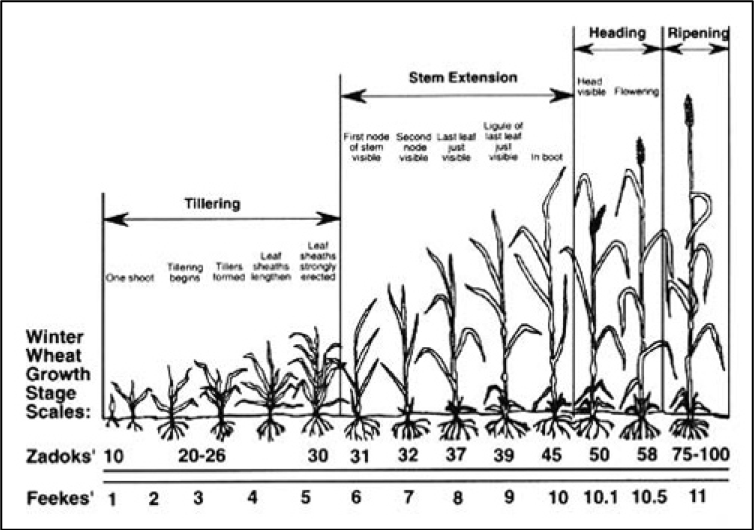Nutrient Management in Wheat
Article Written By: Nicole Fiorellino, University of Maryland
Nitrogen (N) is crucial for optimal plant growth. In wheat production systems, the timing of N application, especially to winter wheat, is almost as important as the amount applied. Navigating when to apply N to a growing wheat plant can be made easier with a better understanding of how the wheat plant utilizes applied N. Winter wheat grown in Maryland is planted in the fall, typically after corn is harvested. To maximize potential yield, the goal is to plant wheat early enough to allow for emergence and production of multiple stems off one parent shoot, or tillering, before the wheat goes dormant during the winter months. Some N is required by the plant in the fall to develop a strong root system, ensuring winter survival. After a typical corn crop, there tends to be enough residual N in the soil to provide the N required for wheat to begin growing. In years where precipitation may have leached residual N from the soil or where corn yields were very high, growers may question if there is a sufficient quantity of residual N in the soil for the wheat crop. In Maryland, the fall soil nitrate test (FSNT, Kratochvil and Steinhilber, 2013) was developed to provide guidance on profitable fall N application to small grains that minimizes potential environmental losses of applied N. The FSNT does not recommend more than 30 lbs N to be applied. An insurance application of N in the fall may not be profitable or used by the crop. Timely planting, to allow for more growth prior to lower temperatures, is recommended; with research demonstrating late-planted wheat is unable to respond to N applied in the fall (Weisz, 2013). With low temperatures and minimal crop demand for N, over-application of N in the fall will not increase crop yield potential, the N is mainly at risk for loss to the environment.

Figure 1. Growth stages of winter wheat in both Zadoks’ and Feekes’ scales.
Throughout the winter months, the wheat plant is dormant and, therefore, no N application is necessary because the plant will not utilize it. As temperatures warm in the spring months, N application can resume around green-up (Feekes’ GS 2/3, Figure 1) as the wheat is tillering but before rapid growth during stem elongation (Figure 1). It is generally recommended to apply spring N in two applications, one around spring green-up and the second just prior to jointing or stem elongation (GS 6/7). The first N application will stimulate the formation of additional tillers, however care should be taken not to apply spring N too early during tillering, as early N application can decrease stalk strength, making plants weak, spindly, and susceptible to diseases and lodging later in the season. Fields where tillering appears to be minimal should be the first to receive a spring N application. During stem elongation, the wheat plant requires a large amount of N to develop leaf area and seed heads. Without enough N, the crop will abort tillers and yield will be decreased. For growers where only one N application will be made in the spring, the application should be applied closer to jointing (GS 6/7) to ensure the N is available as the plant enters its rapid growth phase. A foliar application just after flowering (GS 10.5) may increase protein content, especially in hard wheats, but cannot be relied on to save a low yielding crop. Moreover, as protein content of wheat increases, yield tends to decrease.
There are a number of tools that exist to assist with N management decisions in wheat, for example Greenseeker, and these tools are able to read the greenness of the plant and compare it to in-field high- and low-N reference strips. Then, an algorithm is used to generate an N application rate based on the comparison of the plant to the reference strips. Whether implementing an N management tool or following your state’s nutrient recommendations for wheat production, the general principle is the same – provide N to the wheat plant through multiple applications when the plant is actively growing. Too much N applied when the plant does not require it will be an unnecessary cost to the grower and can potentially negatively impact the surrounding environment.
References
- Alley, M.M., P. Scharf, D.E. Brann, W.E. Baethgen, and J.L. Hammons. 2019. Nitrogen Management for Winter Wheat: Principles and Recommendations. Virginia Cooperative Extension, Publication 424-026. Available at: https://www.pubs.ext.vt.edu/content/dam/pubs_ext_vt_edu/424/424-026/SPES-82.pdf.
- Kratochvil, R.L. and P. Steinhilber. 2013. Fall Soil Nitrate Test (FSNT). University of Maryland Extension, Extension Brief EB-15. Available at: https://extension.umd.edu/sites/extension.umd.edu/files/_images/programs/anmp/EBR-15%20Fall%20Soil%20Nitrate%20Test.pdf
- Weisz, R. 2013. Small Grain Production Guide. North Caroline Cooperative Extension Service. Available at: https://content.ces.ncsu.edu/pdf/small-grain-production-guide/2017-02-06/AG580-web.pdf